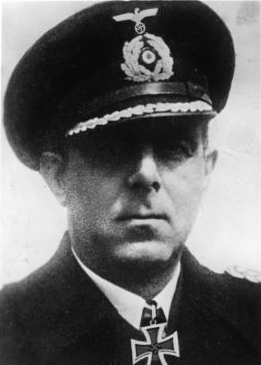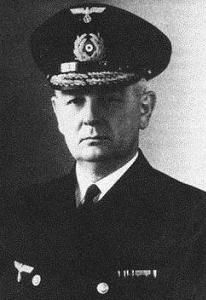
The Kriegsmarine was the navy of Nazi Germany from 1935 to 1945. It superseded the Imperial German Navy of the German Empire (1871–1918) and the inter-war Reichsmarine (1919–1935) of the Weimar Republic. The Kriegsmarine was one of three official branches, along with the Heer and the Luftwaffe, of the Wehrmacht, the German armed forces from 1935 to 1945.

Otto Ernst Lindemann was a German Kapitän zur See. He was the only commander of the battleship Bismarck during its eight months of service in World War II.

Hellmuth Guido Alexander Heye was a German admiral in World War II and politician in post-war Germany. He was a recipient of the Knight's Cross of the Iron Cross of Nazi Germany.

Friedrich Oskar Ruge was an officer in the German Navy and recipient of the Knight's Cross of the Iron Cross of Nazi Germany. He served as the first commander of the post-war German Navy.

Theodor Burchardi was an Admiral with the Kriegsmarine during World War II and recipient of the Knight's Cross of the Iron Cross with Oak Leaves of Nazi Germany. He was responsible for organising the evacuation of 2 million people from Courland and Eastern Prussia at the end of World War II in Operation Hannibal and the Evacuation of East Prussia.

Theodor Krancke was a naval commander and admiral of Germany during World War II and a recipient of the Knight's Cross of the Iron Cross with Oak Leaves.

Rolf Hans Wilhelm Karl Carls was a high-ranking German admiral during World War II. He was a recipient of the Knight's Cross of the Iron Cross of Nazi Germany.

Wilhelm Meisel was an Admiral of the Kriegsmarine of Nazi Germany during World War II and a recipient of the Knight's Cross of the Iron Cross.

Hans-Jürgen "Hansjürgen" Rudolf Reinicke was a Kapitän zur See, commander of heavy cruiser Prinz Eugen, in Nazi Germany's Kriegsmarine during the Second World War and recipient of the Knight's Cross of the Iron Cross.

Kurt-Caesar Hoffmann was a senior naval commander in the German Navy (Kriegsmarine) during World War II, who commanded the battleship Scharnhorst. He was a recipient of the Knight's Cross of the Iron Cross.

The Adriatic campaign of World War II was a minor naval campaign fought during World War II between the Greek, Yugoslavian and Italian navies, the Kriegsmarine, and the Mediterranean squadrons of the United Kingdom, France, and the Yugoslav Partisan naval forces. Considered a somewhat insignificant part of the naval warfare in World War II, it nonetheless saw interesting developments, given the specificity of the Dalmatian coastline.

Grille was an aviso built in Nazi Germany for the Kriegsmarine in the mid-1930s for use as a state yacht by Adolf Hitler and other leading individuals in the Nazi regime. The ship received a light armament of three 12.7-centimeter (5 in) guns and was fitted to be capable of serving as an auxiliary minelayer. Completed in 1935, her experimental high-pressure steam turbines, which were installed to test them before they were used in destroyers, required significant modifications and the ship finally entered service in 1937. Over the next two years, she was used in a variety of roles, including as a training vessel and a target ship, in addition to her duties as a yacht.

The organization of the Kriegsmarine refers to the operational and administrative structure of the German Navy from 1935 to 1945. Many of the organizational tenets of the Kriegsmarine were inherited from its predecessor the Reichsmarine. As World War II unfolded, the Kriegsmarine expanded to cover additional regions and responsibilities, most significant of which was the occupation of France and the Battle of the Atlantic.
Naval regions and districts were the official shore establishment of Nazi Germany's Kriegsmarine during World War II. The Kriegsmarine shore establishment was divided into four senior regional commands, who were in turn subordinated to the operational Navy Group commanders who commanded all sea and shore naval forces within a particular geographical region. Within each naval region were several subordinate naval districts who were responsible for all navy shore activities within their area of responsibility, most significantly were the various German ports of occupied Europe.

Leopold Siemens was a Vice admiral in the Kriegsmarine during World War II. He served as captain of the cruiser Karlsruhe in the mid 1930s and held the short lived position of Deputy fleet commander of the German Navy in 1941.

Surface flotillas of the Kriegsmarine were organizational groupings of German naval vessels during World War II based on class of vessel and geographical location. Surface flotillas were not operationally deployed units, but functioned through the administrative command chain of the Kriegsmarine.
A type commander in the Kriegsmarine was a permanently assigned administrative officer in the organization of the Kriegsmarine which oversaw the development, deployment, and in some cases operational activities of the various classes of German naval vessels. Due to cross jurisdiction with the Navy group commanders, who tactically commanded all vessels at sea, some type commanders were little more than ceremonial officers who held a title with little authority. Others, such as Karl Dönitz who commanded the German U-boat force, exercised near total independence and held enormous authority, both operationally and administrative.
Fritz Krauss was a German naval officer, most recently a Konteradmiral in the World War II. Between 16 August 1944 – 22 July 1945, Fritz Krauss was Director of Department of Naval Intelligence, specifically 3 SKL/MND IV of the German Navy.

Ludwig Stummel was a German career signals officer with the rank of Konteradmiral, who had a glass eye and a limp and who was in effect, the Chief of Staff of the Naval Warfare department, Naval Communications (4/SKL) of the Kriegsmarine. Stummel was most notable for being the person responsible for the cryptographical security of the Enigma cipher machine and Key M infrastructure security, during World War II. Stummel was replaced at the Kriegsmarine Naval War Command on the 16–17 August 1944 by Fritz Krauss, after becoming ill. Stummel was a fervent Catholic. His faith gave him a moral compass during the latter years of the war. Initially a supporter of Nazis, he became doubtful as the war progressed. He was released from the Kriegsmarine in February 1945.















